If you’re searching how to stop getting bored with meal prep, you’re probably stuck in a loop of eating the same things over and over again, tired of chicken, rice, and broccoli staring back at you from identical containers. This article is here to fix that. You’ll find 9 practical, creative tips to help you avoid meal prep boredom, keep your weekly food fresh and exciting, and finally look forward to what’s in your fridge without sacrificing health, budget, or time.
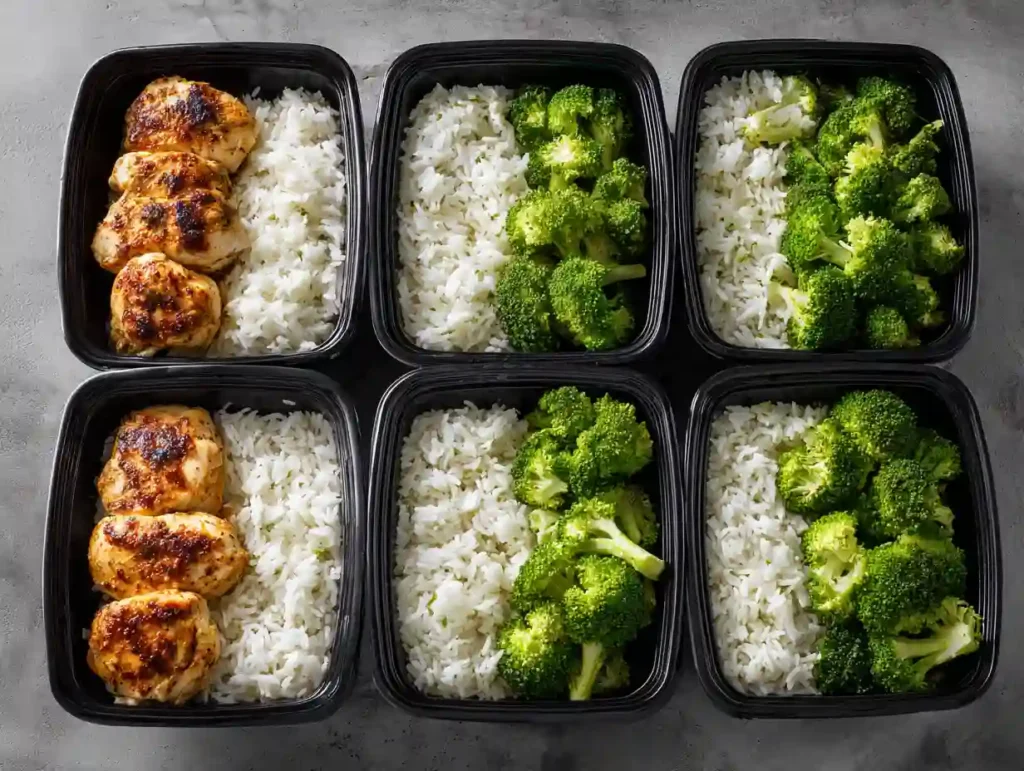
I’ve been there. Meal prepping helped me save money, eat healthier, and stay consistent but after a few weeks, I dreaded opening my containers. I tried switching recipes, but the problem wasn’t just the food. It was the repetition. Once I learned how to remix ingredients, rotate cuisines, and use tools like freezer-safe storage, spice kits, and apps like MyFitnessPal to track variety, everything changed. Meal prep became something I enjoyed again, and I’m going to show you how to do the same.
Jump To
Why We Get Bored with Meal Prep
Meal prepping is praised for saving time, cutting costs, and supporting healthier eating but despite its benefits, many people still find themselves bored eating the same thing day after day. Whether you’re trying to stick to Whole30, calorie tracking through MyFitnessPal, or just aiming to avoid eating out of boredom, the repetition can feel mentally exhausting. This section explores why meal prep boredom happens in the first place and what it reveals about our relationship with food, routine, and variety.
The Repetition Trap: Same Meals, Same Flavors
One of the biggest reasons people get tired of meal prep is simple: we’re eating the same things over and over again. This is especially common when prepping in bulk like making a huge pot of chili or grilled chicken and dividing it across five days. While this may be efficient, it triggers what psychologists call “sensory-specific satiety” the tendency to lose interest in a food the more frequently we consume it, even if we initially liked it (Rolls et al., Appetite Journal).
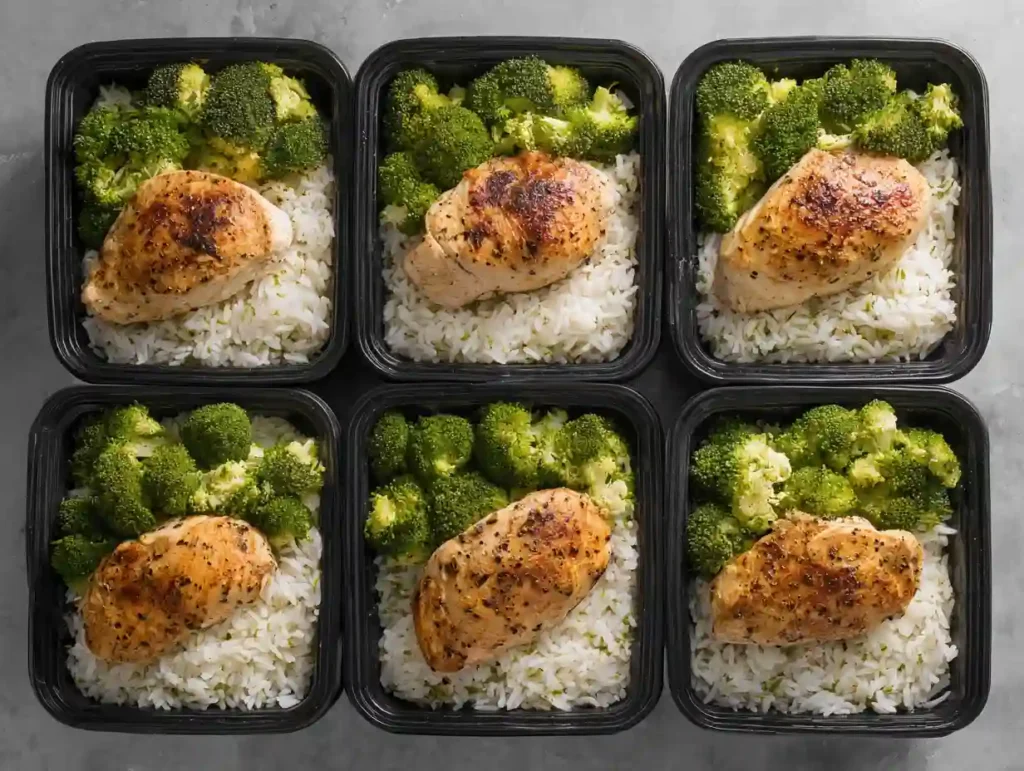
Even small variations can make a difference. Rotating between cumin-spiced chickpeas one day and smoky paprika the next engages different taste receptors. Tools like pre-blended spice packs (e.g., Trader Joe’s, McCormick, or Spice House) or citrus-based marinades can help reawaken flavor without redoing your entire recipe.
Meal Prep vs. Food Variety Needs
Humans are hardwired to seek variety in flavor, texture, and even color it’s part of our survival instinct. Diets that lack diversity are not only boring but also nutritionally limited. According to the Harvard T.H. Chan School of Public Health, dietary diversity is linked to better gut health, micronutrient intake, and long-term dietary adherence. Yet many meal prep plans unintentionally reduce diversity by sticking to a few go-to ingredients for ease and consistency.
The problem? A “chicken, rice, and broccoli” template may check all the macros, but it doesn’t satisfy our sensory or emotional needs around food. Visual monotony plays a role, too. Studies show that color-rich meals improve meal satisfaction something easily enhanced by including roasted vegetables, fresh herbs, or toppings like sesame seeds and pickled onions.
Mental Burnout from Rigid Routines
Beyond the plate, boredom stems from mental fatigue. When meal prep turns into a rigid ritual, every Sunday, same containers, same recipes, same order it stops feeling like a helpful habit and starts to feel like a chore. This is especially true for those juggling work, kids, or fitness goals, where the brain starts associating food prep with duty, not pleasure.
Apps like Mealime or Paprika can break this pattern by offering random weekly suggestions based on your diet style from Mediterranean to low-carb. Another hack is switching your prep day or time: something as small as prepping on Saturday morning instead of Sunday night can shift your mindset from obligation to intention.
How to Stop Getting Bored with Meal Prep (9 Tips)
If you’re tired of eating the same thing every day, you’re not alone. The key to sustainable meal prep isn’t just about planning ahead it’s about maintaining variety without creating more work. These 9 tips are designed to help you enjoy meal prepping again by incorporating flexibility, flavor, and smart kitchen strategies.
Whether you’re following a high-protein plan, Whole30, or just want to eat better without burning out, these practical approaches can break the cycle of food boredom and help you stay on track.
Tip 1: Use One Ingredient in Multiple Ways
Choose a single staple ingredient, like grilled chicken, roasted sweet potatoes, or quinoa, and repurpose it across different meals to avoid bored eating. For example, shredded rotisserie chicken can become taco filling on Monday, tossed in a Caesar wrap on Wednesday, and added to a curry by Friday. This approach works well with batch-cooked proteins, roasted vegetables, and starches like rice or lentils.
Tools like reusable silicone containers or bento boxes (e.g., from Bentgo or Prep Naturals) allow you to portion and store each variation easily while keeping components fresh.
Tip 2: Rotate Cuisines Weekly
Changing up your culinary theme each week is one of the simplest meal prep hacks to not get bored. Instead of falling into a repetitive flavor rut, rotate through cuisines like Mediterranean, Thai, Mexican, or Indian. For example:
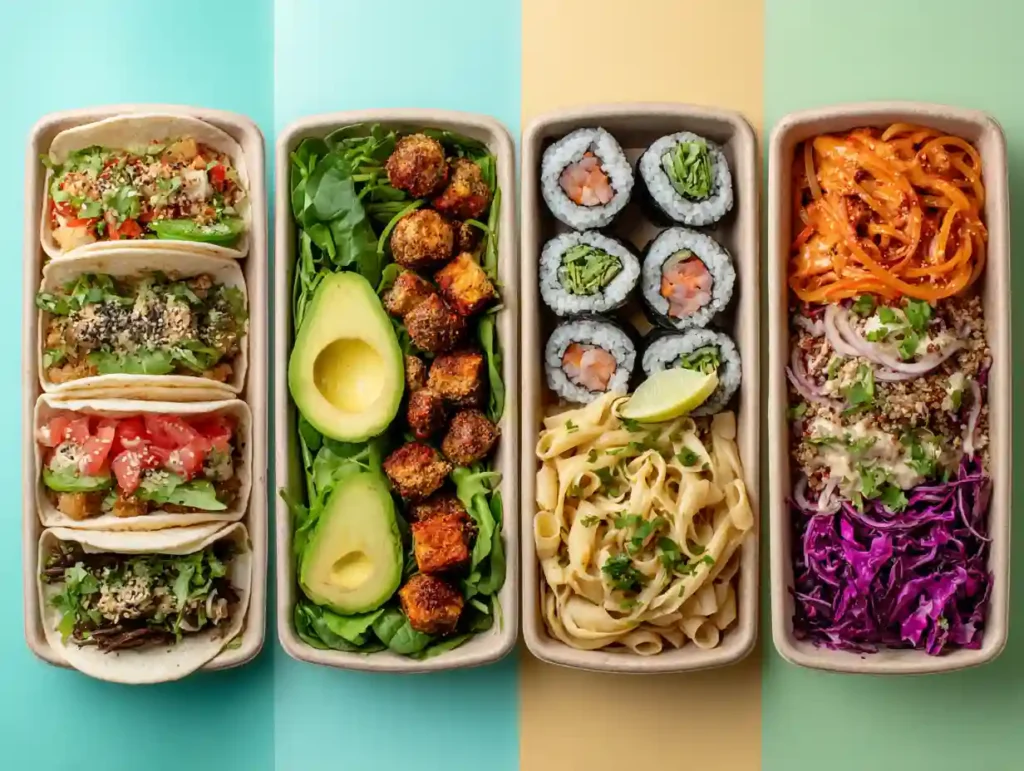
- Week 1: Italian pesto chicken, roasted tomatoes, balsamic vinaigrette
- Week 2: Middle Eastern falafel, hummus, tahini-dressed greens
- Week 3: Korean-inspired bulgogi beef, pickled carrots, sesame rice
This method introduces new flavor profiles and naturally increases dietary diversity without overcomplicating prep.
Tip 3: Use Freezer-Friendly Variety Packs
If you’re asking, Does anyone get bored eating the same thing all week? the answer is yes, and freezer packs are your solution. Divide meals into single-serve freezer-safe containers and alternate between them throughout the week. For example, freeze portions of chili, turkey meatballs, and tofu stir-fry, then rotate what you thaw and eat each day.
This technique prevents “flavor fatigue” while maintaining the convenience of traditional meal prep. Use quality containers like those from Snapware or Pyrex to prevent freezer burn and preserve taste.
Tip 4: Try a Sauce or Seasoning Rotation System
Sometimes all it takes to make a meal feel new is a different sauce or seasoning blend. Create a “sauce bank” with small jars of options like chimichurri, peanut sauce, tzatziki, or buffalo yogurt dip. Pair them with grilled proteins or roasted vegetables for completely different experiences from the same base recipe.
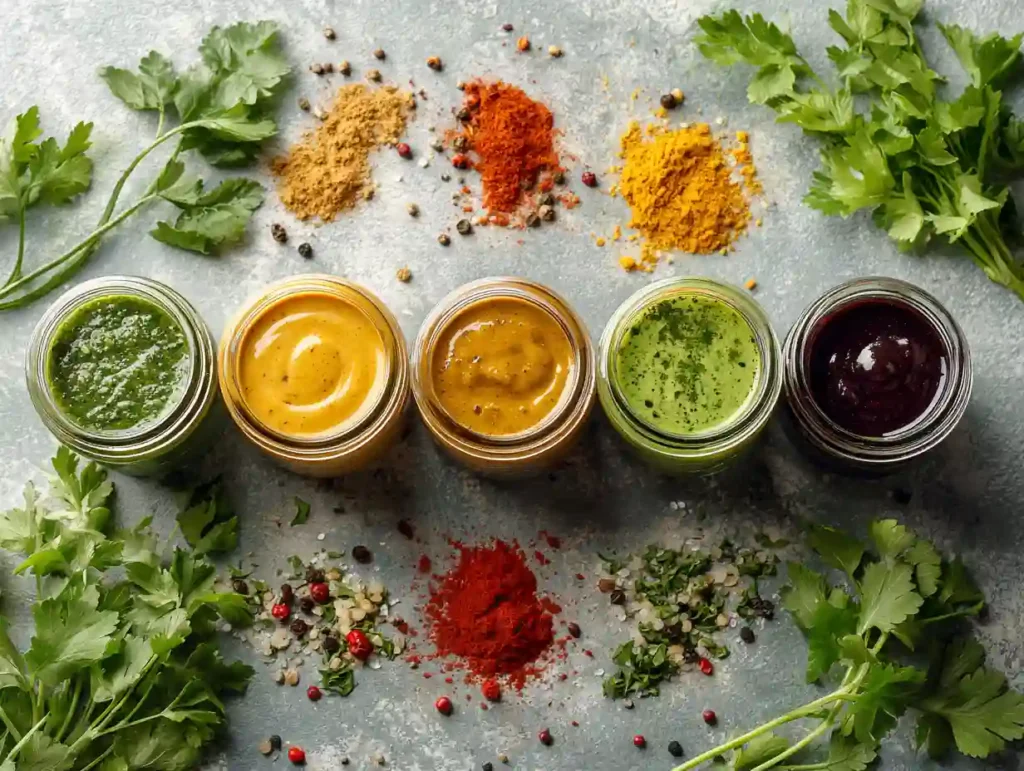
Pre-made seasoning packets from trusted brands (e.g., Simply Organic, Primal Palate) or spice delivery kits can also help you diversify without extra prep time. This tactic supports ways to make meal prep not boring without changing your entire cooking routine.
Tip 5: Add Color and Texture to Every Box
Monochrome meals are visually and emotionally dull. Add interest with:
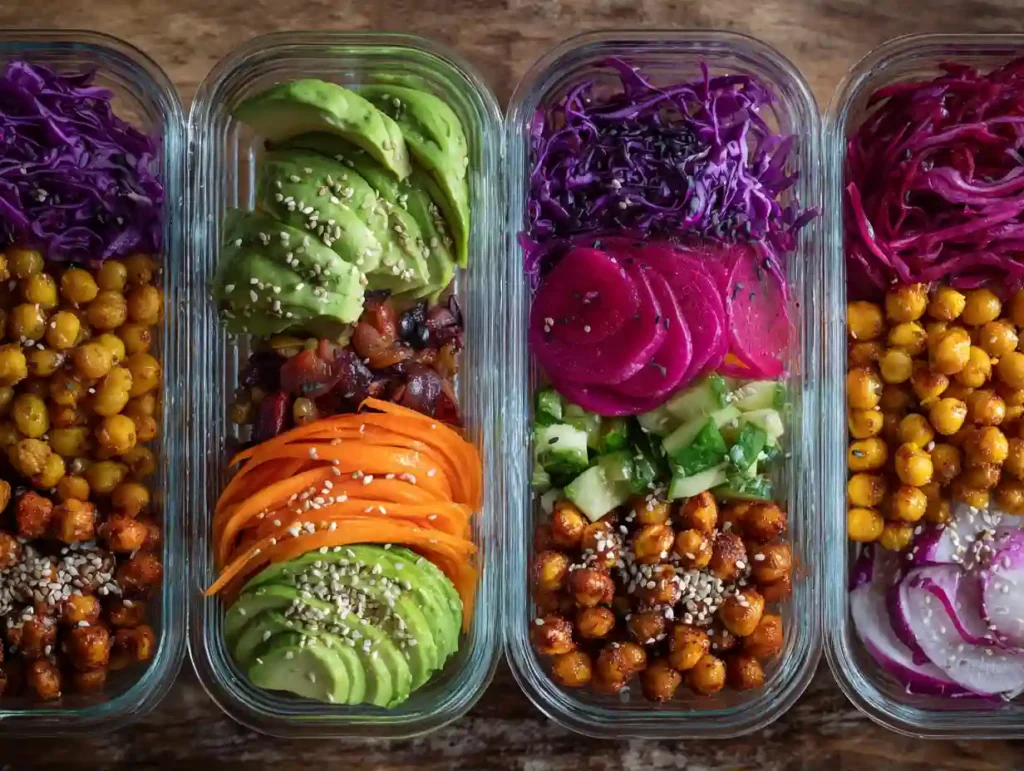
- Red cabbage slaw for crunch
- Roasted chickpeas or toasted nuts for texture
- Pickled onions, sliced radishes, or shredded carrots for brightness
Not only does this boost meal prep variety, but it also aligns with dietary guidelines that promote colorful plates for optimal nutrient coverage (USDA MyPlate). Using garnishes like fresh herbs, citrus wedges, or pomegranate seeds can transform bland bowls into something worth looking forward to.
Tip 6: Batch Prep Components, Not Full Meals
Instead of assembling full meals in advance, prep components like cooked grains, chopped vegetables, marinated proteins, and sauces then mix and match as needed. This “modular prep” method allows for real-time creativity and keeps meals fresh.
Apps like MealPrepPro or PlateJoy support this approach by letting you plug in ingredients and generate new combinations each day. It’s a flexible solution for anyone asking how do you not get bored with the same thing every day?
Tip 7: Remix Leftovers Creatively
Leftovers don’t have to mean reheating the same meal. Reimagine them into new formats:
- Roasted veggies → grain bowls or breakfast hash
- Grilled chicken → quesadillas or Thai lettuce wraps
- Cooked lentils → veggie burgers or soups
Creative remixes keep your meals exciting while minimizing waste. Even basic items like cooked rice can be reinvented into fried rice, burritos, or stuffed bell peppers.
Tip 8: Add One New Recipe Each Week
Sticking to your core favorites is fine, but adding just one new recipe a week can fight off meal prep fatigue. It could be as simple as trying a new salad dressing, swapping in farro for rice, or exploring a plant-based entree like lentil dal.
Use tools like Pinterest boards, the New York Times Cooking app, or Bon Appétit’s “Make This Tonight” section to explore new ideas without becoming overwhelmed. This small change can help you avoid eating the same things over and over again.
Tip 9: Keep Emergency Prep Swaps in Your Freezer
Stock your freezer with easy “backup” options so you’re not stuck eating the same thing if a plan falls through. Ideas include:
- Frozen shrimp stir-fry kits
- Pre-portioned soup or stew
- Store-bought veggie burgers (e.g., Dr. Praeger’s, Hilary’s)
These quick-swap options reduce burnout, help prevent food boredom, and support long-term consistency. Just be sure to label and rotate freezer meals to avoid the dreaded mystery container syndrome.
Planning a Week of Meals Without Losing Interest
Meal prep often fails not because we lack discipline, but because we forget to plan for interest. A week’s worth of food shouldn’t feel like a punishment or a bland routine. By intentionally combining familiar go-tos with small experiments, and building structure that still allows for spontaneity, you can avoid the mental fatigue that leads to bored eating or spontaneous takeout.
This section focuses on how to build weekly meal plans that support consistency and enjoyment, helping you stay committed without getting bored.
How to Mix Familiar and New Recipes
The key to consistency is a balance of comfort and curiosity. Instead of reinventing your entire meal prep every week, try a 3:1 ratio for every three familiar dishes you prep, introduce one new recipe. This method grounds your week in routines you trust (like overnight oats, turkey chili, or grilled salmon) while giving you just enough novelty to satisfy the craving for variety.
New recipes don’t have to be complex even switching your protein from chicken to tofu, or using a new sauce like gochujang or tzatziki, can activate different taste pathways and break the cycle of eating the same things over and over again. Apps like Yummly and Tasty can help you filter new ideas based on diet style, cooking time, and ingredients you already have.
Balancing Convenience with Variety
Many people fall into meal prep boredom because they over-prioritize convenience choosing only the fastest, simplest recipes. While simplicity is key, too much of it leads to flavor fatigue. A more sustainable solution is to alternate between “quick prep” meals and slightly more flavorful builds that take just 10–15 minutes longer.
Here’s a practical template:
- 2 Quick Meals: e.g., tuna salad wraps, quinoa bowls with pre-roasted veggies
- 2 Flavor Builds: e.g., sheet pan salmon with lemon-dill sauce, chickpea curry with coconut milk
- 1 Flexible Dish: something modular like tacos, pasta, or stir-fry where you can change toppings or sauces mid-week
Meal planning apps like Eat This Much or Plan to Eat allow you to schedule variety without manual juggling.
Using a 3-Meal Rotation System That Still Feels Fresh
One highly effective strategy to stop getting bored with meal prep is using a three-meal rotation system: choose three main meals to prepare in bulk, then alternate them across the week in a way that feels intentional, not repetitive. For example:
- Monday/Thursday: Thai peanut noodles
- Tuesday/Friday: Baked falafel with lemon rice
- Wednesday/Saturday: Turkey meatballs with marinara and roasted zucchini
Enhance freshness by storing sauces separately, using air-tight glass containers (e.g., from OXO or Ello), and switching up side items like roasted sweet potatoes, side salads, or soups. Freezer-friendly sides can also give the illusion of a “new meal” even when the main stays the same.
This approach hits the sweet spot: enough predictability to simplify your week, enough variety to stay mentally and physically satisfied.
Prevent Meal Prep Boredom Before It Starts
The best way to stop getting bored with meal prep isn’t just to react to boredom it’s to design your prep system to prevent it. That means building variety into your long-term routine before you even start chopping vegetables.
This section shares proactive strategies to help you stay engaged week after week, reduce mental fatigue, and avoid the spiral of meal prep burnout altogether.
Use a Monthly Rotation Calendar
A smart and simple way to avoid eating the same thing all week is to zoom out and plan across a month, not just a week. A monthly meal rotation calendar lets you cycle your favorite dishes across 4–5 weeks, so you’re not repeating the same meals every seven days. This approach reduces decision fatigue while still giving you enough structure to stay on track.
Here’s how it works:
- Pick 12–15 core recipes you enjoy (e.g., stuffed peppers, miso-glazed salmon, lentil curry, burrito bowls)
- Group them into 4 weekly “themes” based on cuisine, seasonality, or protein type
- Plug them into a printable or app-based calendar (e.g., Google Calendar, Notion, or apps like Paprika)
This creates the feeling of variety even with a fixed rotation a powerful way to prevent meal prep boredom from creeping in.
Theme Days (Meatless Monday, Taco Tuesday, etc.)
Themed days are more than a social media gimmick — they’re a proven behavioral strategy to add fun, rhythm, and anticipation to your weekly meals. By assigning a loose theme to each day of the week, you create micro-variations that break routine without increasing prep time.
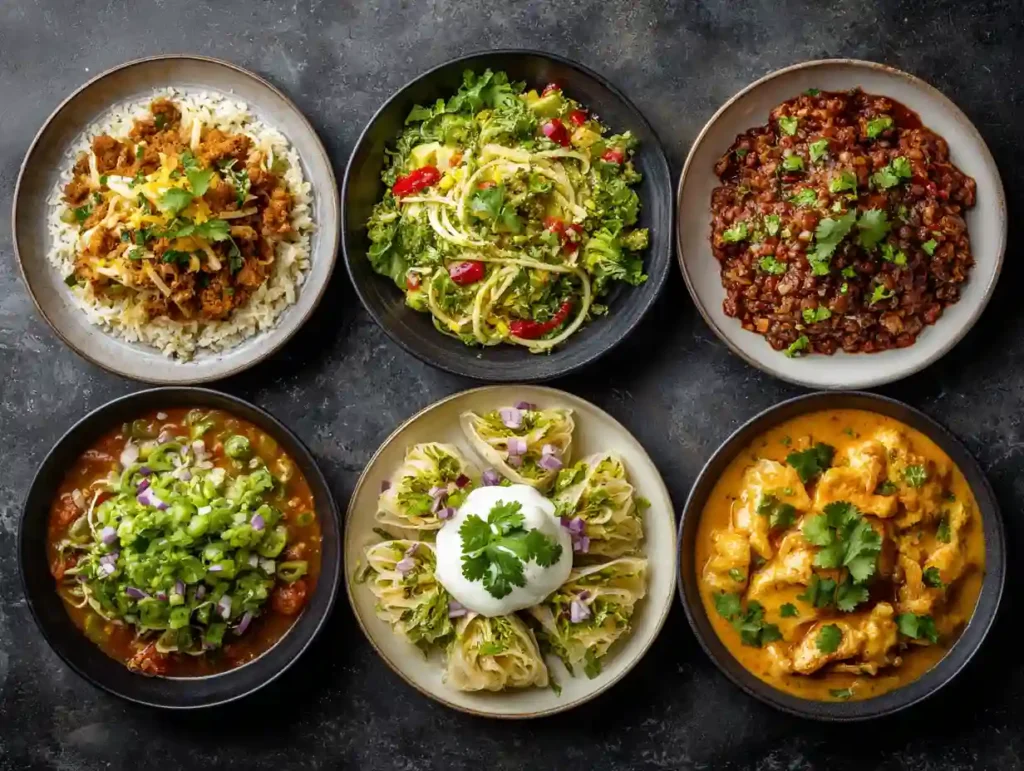
Here are examples of common (and customizable) theme days:
- Meatless Monday: veggie stir-fry, lentil soup, or roasted cauliflower tacos
- Taco Tuesday: traditional, Korean BBQ-style, or even breakfast tacos
- World Wednesday: explore global flavors: Indian, Thai, Mediterranean
- Throwback Thursday: nostalgic favorites like spaghetti and meatballs or shepherd’s pie
- Freezer Friday: eat from your prepped freezer stash
These recurring ideas support habit-building and help you answer the ever-dreaded question: “What should I make this week?” without slipping into repetition.
Create a Prep Template, Not a Menu
Instead of rigidly planning your exact meals, create a prep template a flexible structure based on types of meals rather than specific recipes. For example:
- 2 proteins (e.g., grilled chicken, baked tofu)
- 2 veggies (e.g., sautéed kale, roasted carrots)
- 1 grain (e.g., quinoa, brown rice)
- 1 sauce (e.g., chimichurri, peanut dressing)
- 1 snack (e.g., hard-boiled eggs + cut veggies)
This approach lets you improvise throughout the week using your components in different combinations, giving you more freedom without sacrificing time or quality. It also aligns with how to not be bored with food you stay in control of variety without falling back on takeout or skipping meals altogether.
FAQ
How to meal prep without getting bored?
Rotate cuisines weekly, prep components instead of full meals, and try one new recipe each week. Use sauces, textures, and freezer swaps to keep things fresh.
What is the 3-2-1 meal plan?
It’s a simple formula: 3 proteins, 2 vegetables, 1 carb. Mix and match for variety without overthinking your meals.
How to not get tired of meal prep?
Add small changes weekly — new seasonings, cooking methods, or themed days (like Taco Tuesday). Keep flavor and visual variety in focus.
Conclusion
Staying consistent with meal prep doesn’t have to mean sacrificing variety or enjoyment. With just a few small changes, like rotating cuisines, remixing ingredients, and planning with flexibility, you can break free from food fatigue, meal prep downsides and actually look forward to what’s in your fridge. Whether you’re new to meal prepping or just tired of eating the same thing every day, these tips are here to help you keep things fresh without adding more work.
Personally, I love this approach to meal prep because it brought the joy back into my routine. I used to feel boxed in by my containers, same meals, same flavors, zero excitement. But once I started using simple tricks like freezer swaps and sauce rotations, everything changed. Now, I get the convenience I need and the variety I crave. Meal prep doesn’t feel like a chore anymore it feels like freedom.
